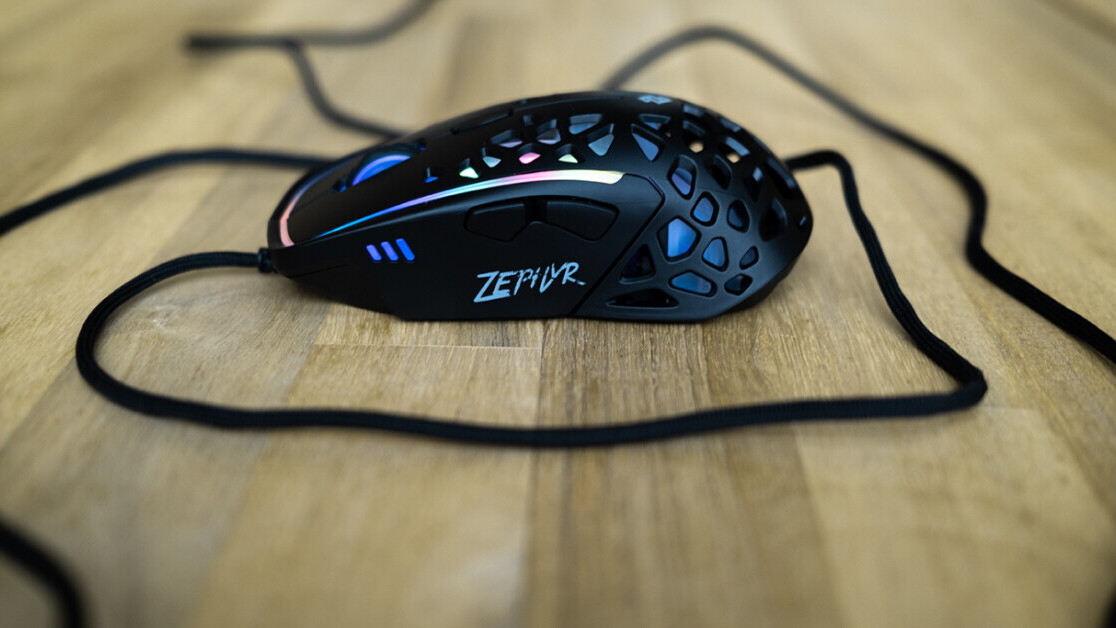
Urban Dictionary defines a sweaty gamer (also known as a sweat) as “a fucking try-hard that ruins the fun in any multiplayer game.” But this figure of speech also has another meaning, one a lot more grounded in reality — literally, a gamer with moist palms.
The true telltale of a sweat is the gunk on their mouse — an accumulation of musky sweat residue that has built up from thousands of hours of grinding to get that K/D up.
But what if things didn’t have to be this way? What if there was gear specifically designed to let sweats be try-hards without any of the intense perspiration that comes with it. Well, there might just be.
Enter Zephyr, a sweatproof gaming mouse built to keep those palms cool and dry — and that K/D as high as the sky.
The device, which is currently on Kickstarter, aims to combine performance and comfort with its ergonomic architecture and built-in cooling system. Yep, you heard that right. The Zephyr’s unique selling point is a tiny fan strategically placed inside the mouse to blow air in your palm.
As a sweat myself, when the Zephyr team offered to lend me a working prototype, I was instantly enthused to temporarily (or perhaps permanently?) bench my beloved Razer Viper Ultimate and put the Zephyr through its paces.
I’ve had the mouse for a couple of days, and while this is by no means a comprehensive review, I’ve got some thoughts.
The Zephyr experience
I can only describe the Zephyr’s aesthetic as aggressively gamer-ish: angular design with lots of detail, all covered in bright RGB lights. It’s practically mouse equivalent of a sweat, a try-hard design.
Look, this whole gaming look isn’t my thing, but gamers must dig it because brands keep putting RGBs on everything. If you’re into it, that’s cool — I’m just not.
There was no way to switch off the lights on my working prototype, but the Zephyr team tells me there will be an off button on the final product.

Speaking of buttons, in addition to the two main ones, you’ll find a scroll wheel, a small button to adjust the DPI on the go below it, and two extra customizable buttons on the left side of the mouse. There’s also a button to control the fan at the bottom of the device.
As you could’ve guessed by the placement of the side buttons, this is primarily a right-handed mouse. I can’t speak for how it’d feel for lefties, but the Zephyr was an immediate fit for me, providing a comfortable grip. I still prefer the shape of the Razer Viper Ultimate, but, in all fairness, I’ve spent over a thousand hours with it, so that probably plays a part.
One thing I particularly liked about the Zephyr is how light it felt in the hand. Thanks to its honeycomb chassis, the mouse weights only 68g (the working prototype I had was a little heavier, but the final product will weigh as advertised according to the Zephyr team). Stuff like that counts when it comes to precision.

Another aspect that helps with precision are the five PTFE feet at the bottom of the mouse. Overall, the feet provide a smooth gliding experience, but my impression is the Zephyr has been optimized for speed rather than control and accuracy (which is not to say that it’s inaccurate).
Unlike my Razer Viper Ultimate, which emphasises control over speed, the Zephyr glides more aggressively — it takes less force to move it along and it slides easier, but it also takes more effort to be precise. Neither approach is good or bad, but if your gaming style involves lots of short, precise strokes, you might need some time to get used to the Zephyr’s speed.
On the inside, the Zephyr is on par with other gaming mice. It supports DPI of up to 16,000 (most pro gamers opt for much lower DPI, by the way) and a polling rate of 1,000Hz. The difference is software. Razer, for instance, lets you control your mouse’s DPI and polling rate with its Synapse app, but that’s not an option with Zephyr.
Indeed, I had to game at 800 DPI, because the dedicated DPI button only allows switching between 800, 1,600, 3,200, 6,400, and 16,000 DPI. The Zephyr team did however tell me there will be a 400 DPI setting programmed into the final version, so at least that.
The cooling system
I’ve been blowing off talking about the Zephyr’s built-in cooling system, but let me say it straight away — it’s not bad, but it’s not as cool as it sounds. It doesn’t blow, but it didn’t blow me away either. You get the idea: it’s a bit gimmicky.
My biggest gripe with it is it feels less like a blow fan and more like a… vibrator… for your hand. I could hardly feel any air directed at my palm when I tried it at the lower setting. There wasn’t much of a difference when I switched to the higher setting either — with the exception of a harder vibrating sensation.
Honestly, it feels like the fan does more to cool off the chassis (which inevitably gets a little warm from all those RGB lights) than your palm. Sure, one has an effect on the other, but I was expecting more of an “air conditioning for your palm” type of thing. That wasn’t it.

After switching back and forth between the Zephyr and the Viper Ultimate (which has far less RGB), my sentiment is both make my palm equally (non-)sweaty. At best, I’ll give a minor edge to the Zephyr. Still, I can’t help but feel that cooling isn’t what the Zephyr does best — even though it’s being advertised as its standout feature.
The Zephyr team tells me the fan in the working prototype I was provided with only functions at 60%-70% of the capacity the final product will support. I’m not sure how to interpret that, but the company says the fan can spin at 10,000 RPM at max. The mouse will support three modes: 4,000, 7,000, and 10,000 RPM.
The company also claims the final product will be a lot quieter, with a maximum noise level of under 25dbs. Personally, I’d like it to be a lot less pulsating, too. Seriously.
The final blow-off
I can’t help but feel conflicted about the Zephyr.
On one hand, I’m not impressed by the built-in cooling system, but, on the other, it’s the only reason it caught my attention. Strip the fan away and it’s yet another gaming mouse I couldn’t care less to try. It’s not that the cooling system is useless — I simply expected it to deliver a more palpable experience.
Gimmicks aside, the Zephyr is a solid gaming mouse, which many gamers will like. I expected switching to a new mouse will affect my performance in Call of Duty: Warzone, but I was able to maintain my K/D without a problem in the short time I used it.

So what’s the issue, you might ask. Price and reliability.
As with other products from companies with unproven records (and crowdfunding campaigns in general), I’ve got some concerns about its longevity and promised features. The working prototype I tested had some kinks Zephyr transparently explained it plans to address. I’ve got no reason to believe that won’t be the case, but it’s something to keep in mind.
Mice are known to break easily (even the good ones do) and that honeycomb chassis is bound to let in tons of dust and particles on the inside. This could lead to issues. On the upside, Zephyr ships with a free blower to clean the chassis, so hopefully that helps.
While the cooling experience isn’t exactly mind-blowing, it turns out that building technology to blow air in your palm might also blow your pockets empty. You can pre-order the Zephyr at a discount for $79 on Kickstarter (the Zephyr team hopes to start shipping in October), but the mouse will cost $158 once it retails officially.
That puts it in the same budget bracket as well-established (and also wireless) alternatives like the Razer Viper Ultimate and the Logitech G Pro.
Sure, you might say none of those have a fan inside them, but the real question is just how much less sweaty does the Zephyr make your palms? And if you ask me, the answer is not much.
You can check out the Zephyr mouse by clicking here.
Get the TNW newsletter
Get the most important tech news in your inbox each week.





